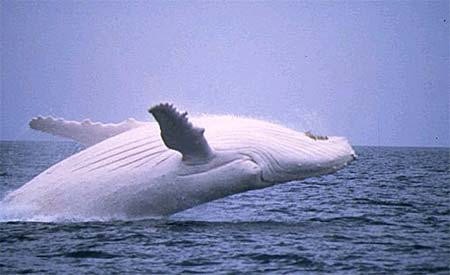Migaloo White Whale sighted in the Whitsundays
by BW Media roundup on 26 Aug 2009

Migaloo, the world’s only known albino humpback whale SW
He's here again!
Migaloo, the white albino whale that has been appearing off our east coast since 1991, has appeared again!
The now famous albino whale was sighted between Hardy Reef and Shute Harbour in the Whitsunday Islands on Tuesday, on his way to tropical waters.
The skipper of Fantasea cruises' vessel Wonder stopped nearby as Migaloo delighted spectators for about half an hour.
'The skipper hovered around for about half an hour so that all the guests on board could have a look,' said a spokeswoman for Fantasea, 'and it's the first time Migaloo's been spotted this season in the Whitsundays we believe.'
Most sailors have mixed feelings about an encounter with a whale, and there are plenty of them at this time of year. None are as popular as Migaloo – believed to be the only pure-white humpback in the world – who has been a magnet for whale watchers since his first sighting off the Tweed coast in northern New South Wales in 1991.
Migaloo is aboriginal for 'white fella', and sightings have been so rare that there was once scientific debate about whether he really existed. After the first signting in 1991, he was not seen for eight years, fuelling speculation he had died of skin cancer or fallen prey to killer whales.
However, with more than 50 sightings along Australia's eastern seaboard since 1991, Migaloo has become a phenomenon in the global whale-watching industry, estimated to be worth more than $1 billion annually.
Long-time Migaloo-watcher David Lloyd, of Lismore’s Southern Cross University Whale Research Centre, has said the white whale is ``the one we look for every year’’.
``It’s almost become a competition between whale researchers to see who’s the first to spot it,’’ he said.
In August 2003, Migaloo survived a scrape with a yacht near Magnetic Island off Townsville on the northern coast of Queensland.
The collision holed the trimaran and tore off the boat’s drop-down rudder, which was feared to have lodged in mammal’s back.
But Migaloo was soon seen swimming freely in waters just north of where the incident happened.
A subsequent examination of Migaloo by Queensland Parks and Wildlife Service officers revealed only a slight wound, confirming the white whale had taken the collision in its stride.
It wasn’t until 2004 that Migaloo’s sex was confirmed - genetic tests on skins which peeled off the albino humpback showed beyond doubt he was male.
Fears Migaloo could be targeted by international hunters sparked a wave of protests across Australia in 2005, with then federal Environment Minister Ian Campbell claiming the whale ``could well be harpooned’’ that season.
Far north Queenslanders and visitors were later warned to keep their distance from Migaloo, or face fines of more than $12,000.
The latest sighting comes as the annual northern migration of the east coast humpbacks hits full swing. University of Queensland whale researcher Mike Noad said the local whale population was recovering after years of over-exploitation.
``This population of whales is the fastest-growing whale population in the world we know of,’’ Dr Noad said.
It is believed there are now 10,000 whales using the east coast migration route from Antarctica as far north as Torres Strait, causing an ever increasing hazard for sailors in the area.
If you want to link to this article then please use this URL: www.sail-world.com/60573